Five-Year Anniversary,
Five Reasons To Focus On Uni-Global – Cross Asset Navigator
A five-year anniversary presents an ideal opportunity to take a step back and perform a thorough and objective analysis of Uni-Global – Cross Asset Navigator (Navigator) to understand how performance was achieved and how it compares to the competition..
The past five years have been eventful, characterised by supportive financial conditions, heavy market stresses, recessionary fears, shifting central bank policy, geopolitical turmoil and swinging valuations. This ever-changing environment is the reality of managing portfolios, requiring adaptability, strong processes and diversified return streams. This is exactly what Navigator is made of, which is why we are confident that its behaviour will be repeatable in the future, no matter what awaits investors in the years to come.
2020 will be a challenging year for flexible asset allocation and investors will need to contend with an upcoming US election, an anticipated global slowdown and high valuations. Now is a crucial time to highlight the benefits of a macro risk-based solution that aims to deliver smooth returns in different market conditions.
There are five points to take away from this paper:
- Navigator delivered attractive risk-adjusted performance over the past five years
- It achieved positive asymmetry in different market conditions
- Its enhanced diversification and dynamic allocation worked as expected
- The process delivered on its promise of reducing risk while enhancing returns
- The strategy has everything it takes to navigate the challenges and opportunities ahead in 2020
A Quick Look at 2019 Performance
2019 was an exceptional year for multi asset strategies, thanks mainly to the “beta party” triggered by central bank easing. In contrast to 2018, when returns on all risk premia disappointed, last year saw a broad-based reversal with most asset classes and cross-asset strategies posting strong returns. If last year had a song, it would be called “Thanks for the Dance, Central Bankers!” and the chorus would be: “The higher the beta to equity, the better the yearly performance”.
In that context, Navigator delivered double-digit returns, outperforming hedging risk premia such as duration and global commodities, and beating most of the key hedge fund indices (HFRX). (Figure 1)
Figure 1: 2019 Performance vs. Key Assets and Hedge Funds Indices
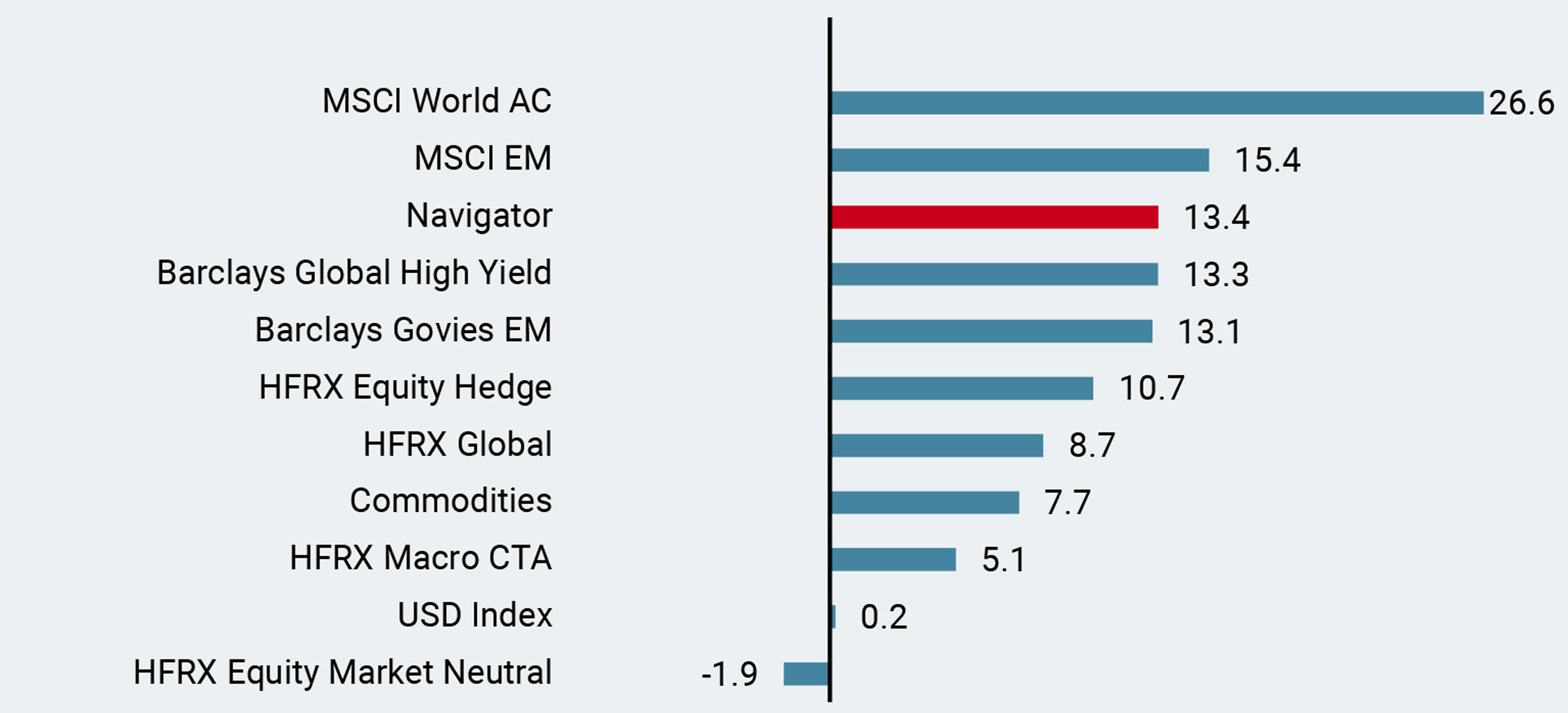
1) Attractive Risk-adjusted Performance over the Last Five Years
Over the last five years, the global economy has grown around potential levels with minimal inflation, allowing most assets to post strong performances. Moreover, accommodative biases from central banks have compressed the risk premia of most risky assets and pushed realised volatility lower. This stable macro scenario has been favourable for balanced portfolios, as shown in Figure 2. In that environment, Navigator has outperformed both key multi asset indices, delivering 23% since December 2014 (net of fees) versus 14% for the Morningstar Flexible Allocation USD and 10% for the Kepler Multi Asset Index.
Figure 2: Performance since Inception
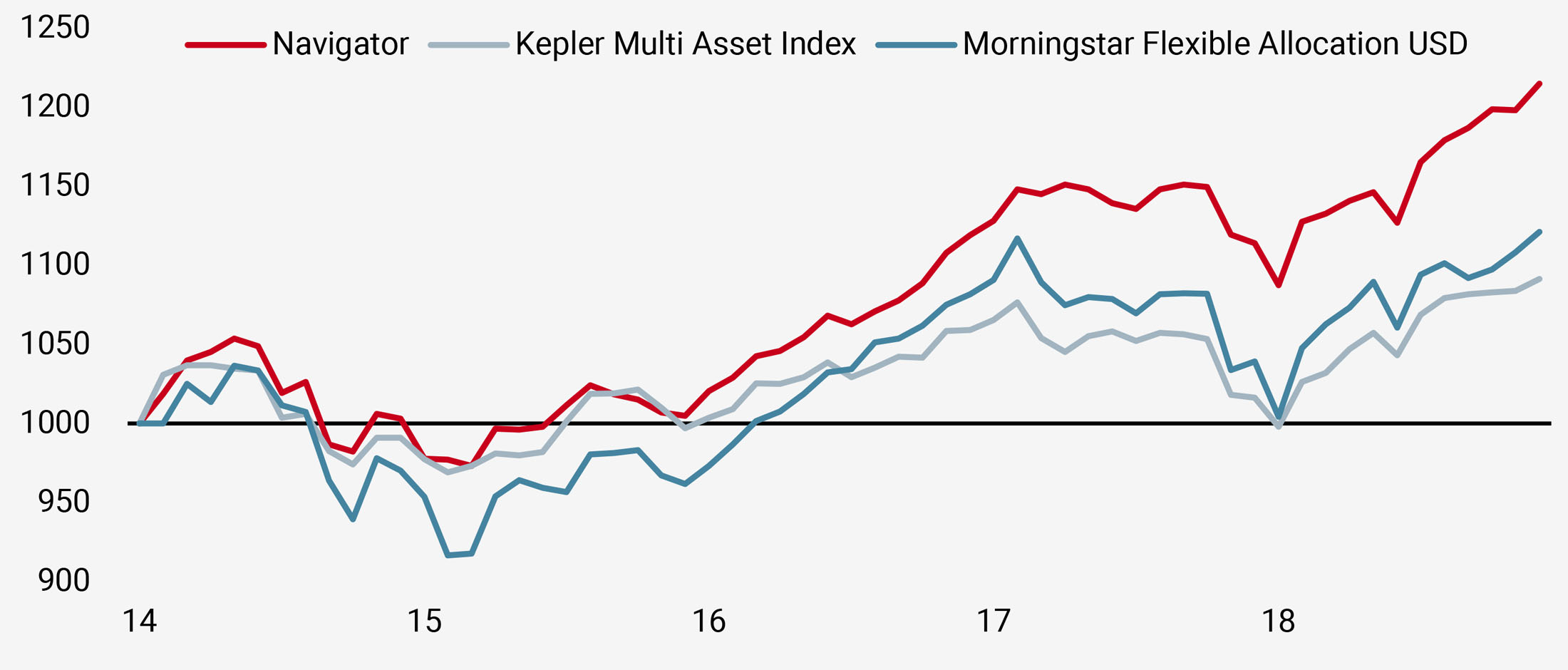
However, headline five-year performance only gives a partial view of the story. Beneath the surface of strong performance for most assets, returns have been far from linear. There have been many events that have triggered large drawdowns in risky assets, including a yuan devaluation in August 2015, the Brexit surprise in June 2016, a VIX spike in February 2018, quantitative tightening in Q4 2018 and US recession fears last year. In our view, the real risk for investors is capital loss, not volatility, so it is crucial to build a portfolio that can limit the negative impact of an equity market sell-off. As illustrated in Figure 3, the two pillars of the strategy, 1) a diversified investment universe and 2) dynamic asset allocation, have both added value in these negative periods for equity markets. The fund has outperformed the Morningstar index 100% of the time and limited its beta-to-equity to 0.2% when equities fell by more than 5% (Figure 3).
Figure 3: Performance During Equity Market Sell-Offs
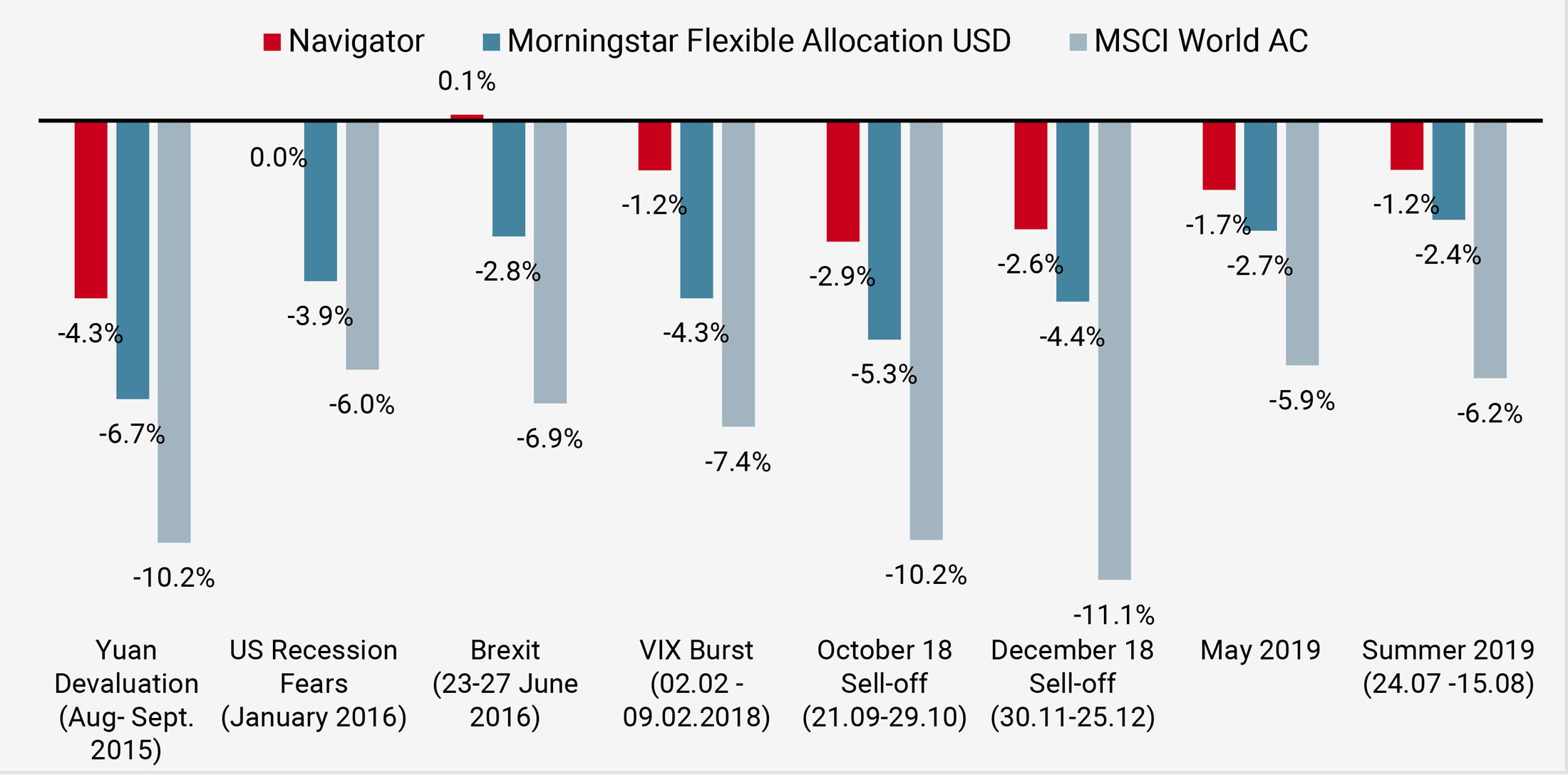
Consequently, the risk-adjusted performance of Navigator has been high and in line with global equity and balanced passive portfolios (Figure 4).
Figure 4: Risk-adjusted Performance since Inception
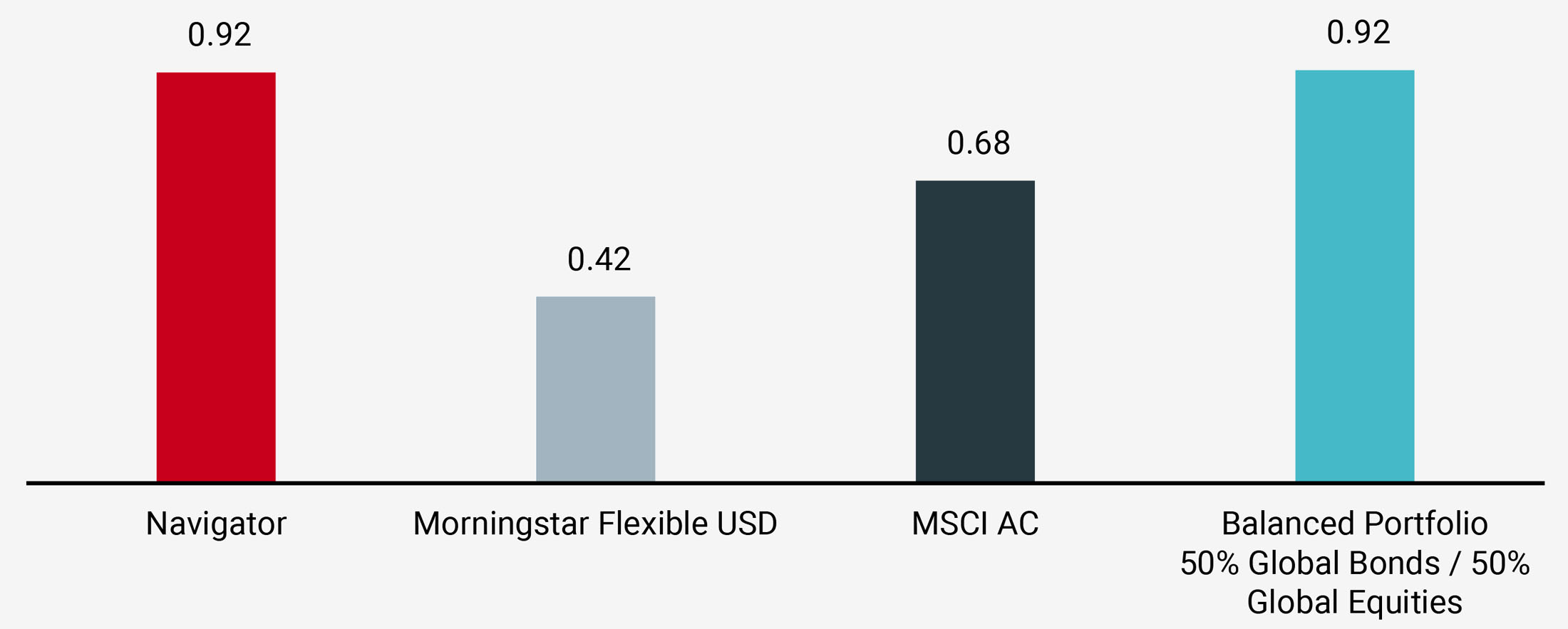
2) Delivered Positive Asymmetry in Different Market Conditions
Navigator aims to deliver smooth and positive returns in different economic contexts and provide positive return asymmetry, ie higher upside than downside participation. As illustrated in Figures 5a and 5b, the strategy has achieved, on average, higher bull market performance capture in bonds and equities than in bear contexts.
Figure 5a: Performance in Rising and Falling Equity Markets
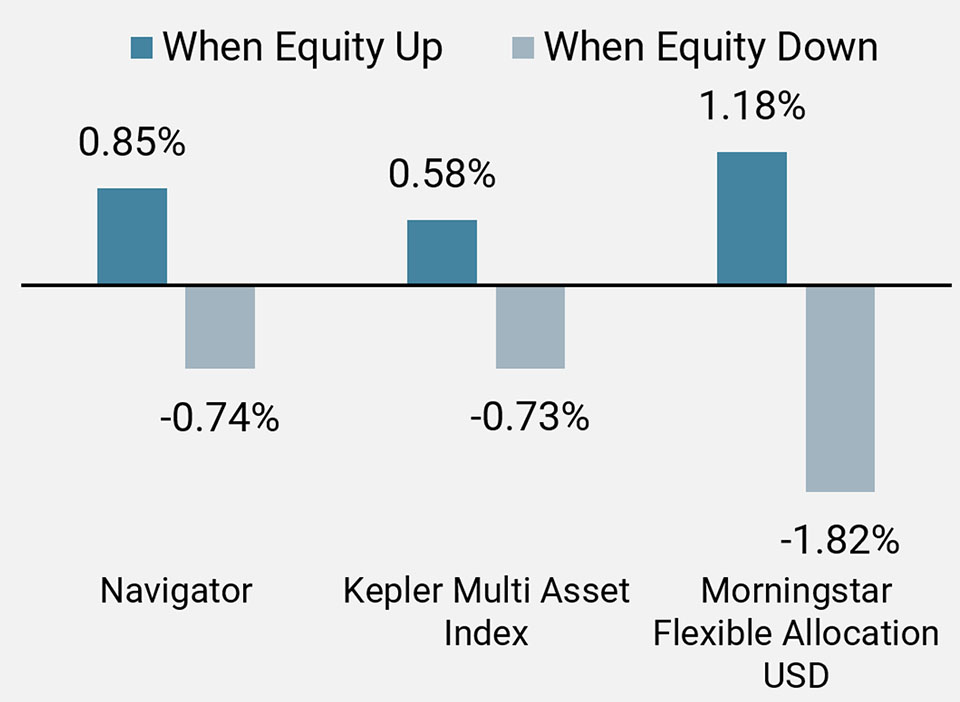
Figure 5b: Performance in Rising and Falling Bond Markets
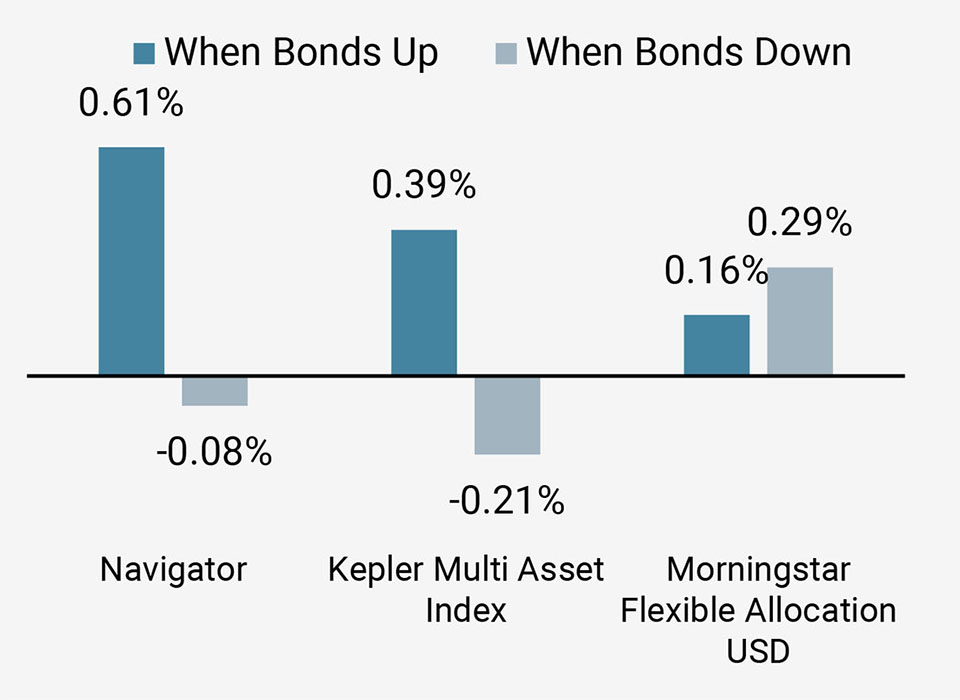
Moreover, thanks to its macro risk-based construction that aims to diversify risk across key macro regimes (recession, inflation surprise, market stress and steady growth), the fund has performed well across different economic conditions. As shown in Figure 5c, the strategy has posted positive returns on average during both monthly declines and increases in the US ISM Manufacturing index.
Figure 5c: Performance when ISM is Rising and Falling
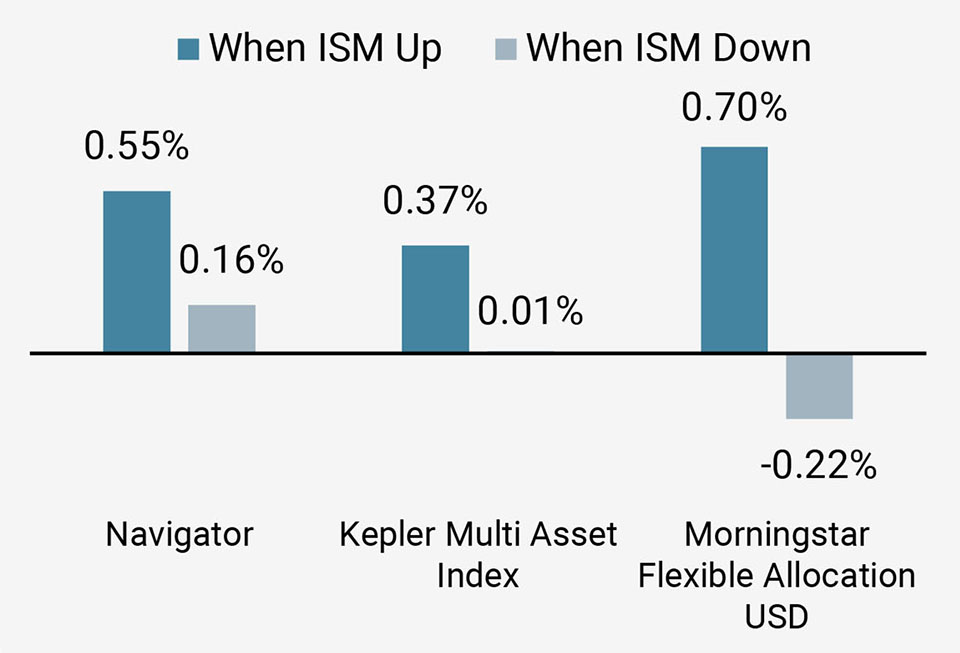
3) Diversified Source of Return
In our view, effective diversification expands the sources of return that drives portfolio performance. A very concentrated portfolio will be driven by only one contributor (e.g. equity) that tends to perform in one specific economic context (growth) or market condition (bull market). In the wake of global quantitative easing, Risk Parity strategies are often cited as a solution to diversify equity risk. This type of multi asset solution has become popular over the past ten years and has delivered attractive returns in many cases. However, traditional balanced portfolio returns have not been as diversified as expected. In 50% / 50% portfolios, equity returns represent on average more than 70% of total performance over the last five years, while duration contribution has been large for Risk Parity strategies, as shown in Figure 6.
Over the period, our expanded investment universe that mixes traditional and liquid alternative risk premia provided a more balanced performance contribution. For example, the contribution from growth assets represents less than 50% of the total performance, and duration less than 25%. The contribution from liquid alternative risk premia accounts for more than 25%, illustrating the benefits of an expanded investment universe that includes both traditional and alternative risk premia.
Figure 6: Performance Contribution by Assets
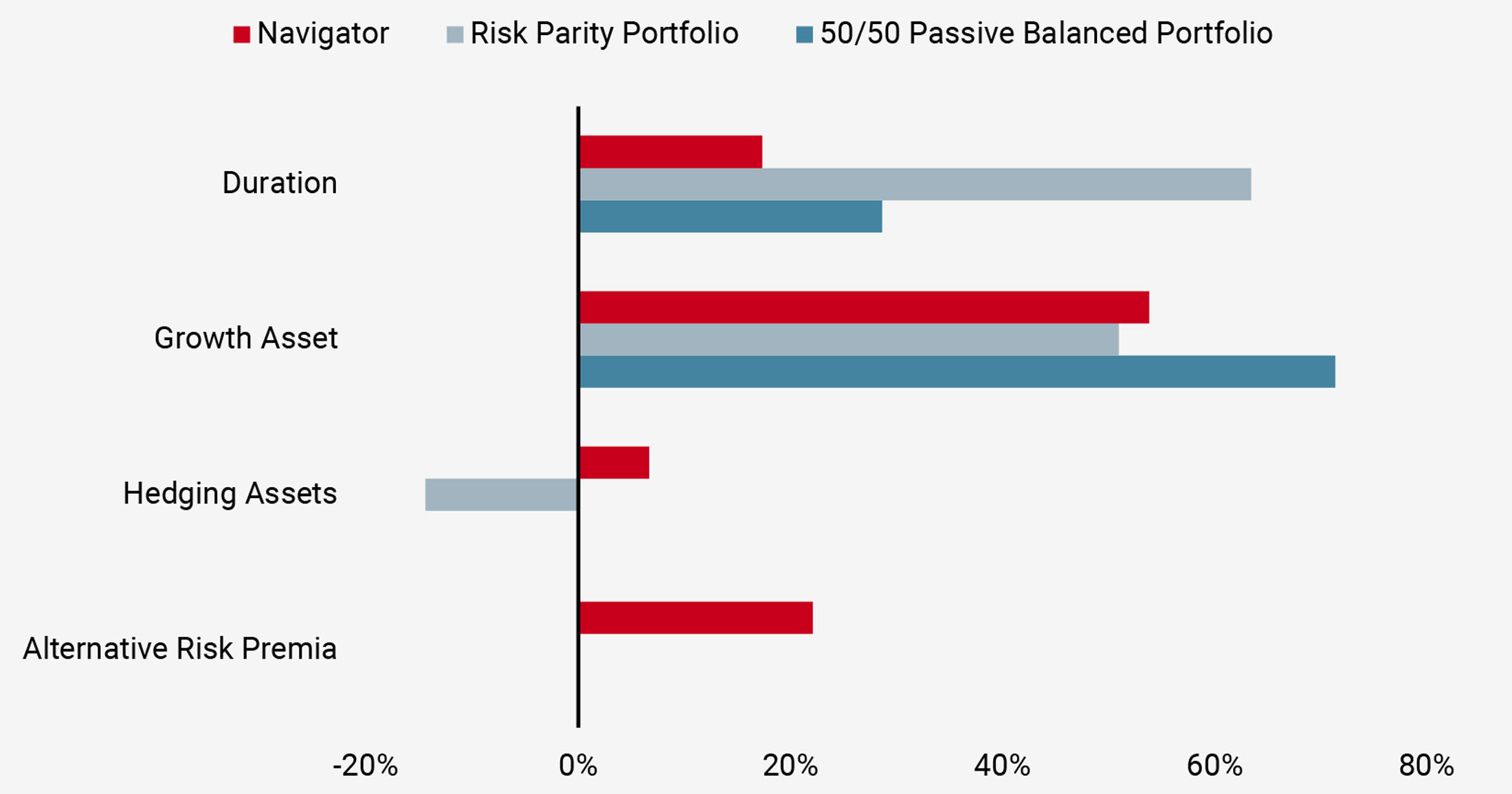
In our view, this highly differentiated return set bodes well for future performance at a time when equities and duration valuations are high and expected returns are low.
4) Robustness in the Investment Process
Our investment process consists of three main building blocks. The strategic book aims to harvest returns from a broad, diversified universe of traditional and liquid alternative risk premia using a risk-controlled framework to provide consistent returns on average across economic regimes. The dynamic book adapts the strategic portfolio to the current economic environment, both in terms of asset allocation within and across risk premia, and in terms of risk targeting. Finally, the opportunistic book takes short-term tactical positions to exploit specific opportunities via relative value trades with an expected low correlation to key risk premia.
This kind of portfolio construction provides full diversification: firstly across time horizons (long-term vs medium and short-term); secondly, across investment styles that mix systematic and discretionary elements; and finally, across risk dimensions with a close monitoring of macro risks, market sentiment and valuation, the three main drivers of asset returns over the long term.
As can be seen below (Figure 7), each component contributed positively to performance on average since inception, consistent with their respective risk targets.
Figure 7: Contribution by Books in Navigator
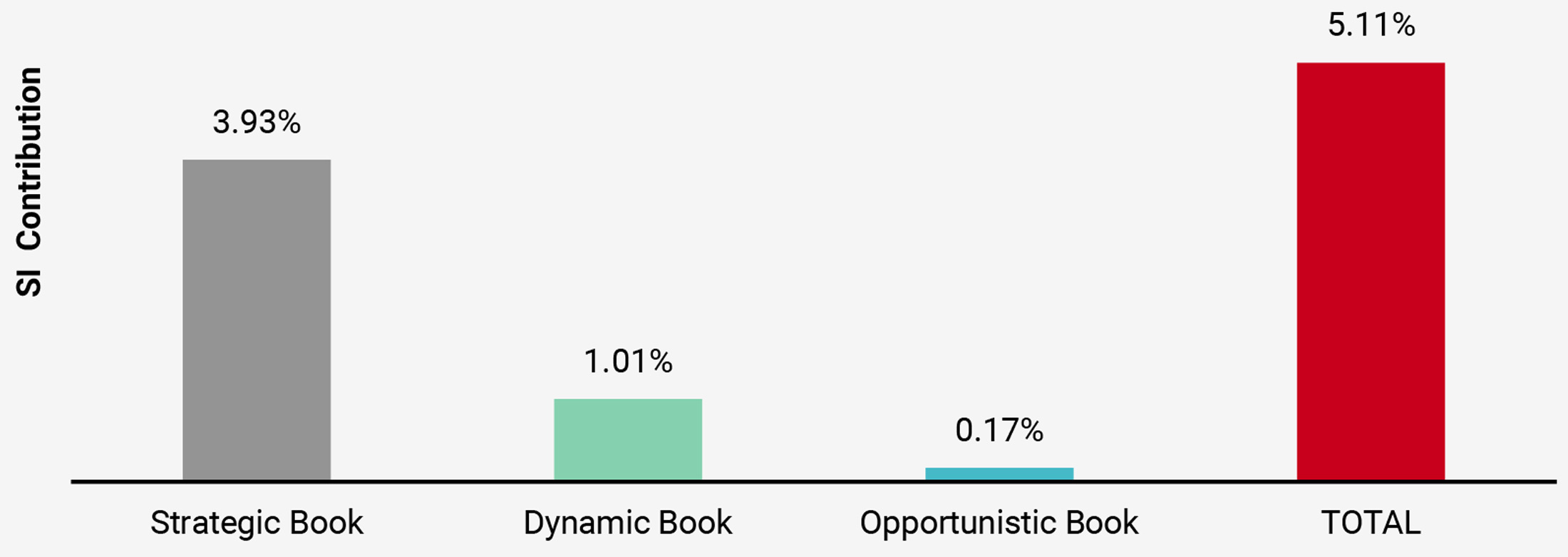
More importantly, the correlation between different elements was low and helped to smooth the return, meaning that dynamic risk management added return without increasing risk, which is the aim of a robust portfolio (Figure 8).
Figure 8: Correlation between Books in Navigator

Over the past five years, we have also developed a dedicated approach to integrating ESG factors into our investment process. Unigestion has been managing ESG/SRI solutions since 2004, including bespoke mandates tailored to reflect clients’ specific ESG criteria. In Navigator, our ESG policy is applied across all the physical assets we invest in (equities, government bonds and commodities), representing 99% of the NAV (excluding cash). Thanks to our dedicated filters, we have improved the ESG scores and the carbon footprint for both equity and bond allocations in the fund, which are managed against key benchmarks, including the MSCI World and Barclays Global Treasury indices. The strategy continues to be a pioneer in ESG investing within the multi asset space.
5) Well Equipped to Navigate Whatever 2020 Holds in Store
The global economy has been slowing since mid-2018. US monetary tightening implemented last year, the decline in global trade growth observed since 2016 and weak activity in Europe have been the main triggers, driving the deceleration over the last 15 months. In addition to weaker activity, rising tensions between the US and China have increased uncertainty, negatively impacting investment perspectives and production expectations.
Despite this broad economic slowdown, 2019 was a great year for global stocks, with the MSCI World index delivering its tenth best annual return since 1970. Historically, such returns for equities were driven by macroeconomic acceleration, an increase in corporate profitability or a positive shock such as globalisation or technological innovation. However, this time the backdrop has been one of slower global growth, unchanged earnings per share and a rise in geopolitical uncertainties and polarisation.
The key difference in 2019 was a globally coordinated central bank shift to a more stimulative stance that served to push growth assets higher. We believe that central bank policy is likely to remain supportive in light of muted inflation pressures that show no signs of increasing. However, the sustained rally has pushed valuations up to levels that we believe are concerning in some areas and 2020’s global political calendar will likely weigh heavily on investor sentiment.
Figure 9a: Growth Tilts for Starting 2020 (capital allocation as of 31.12.2019)
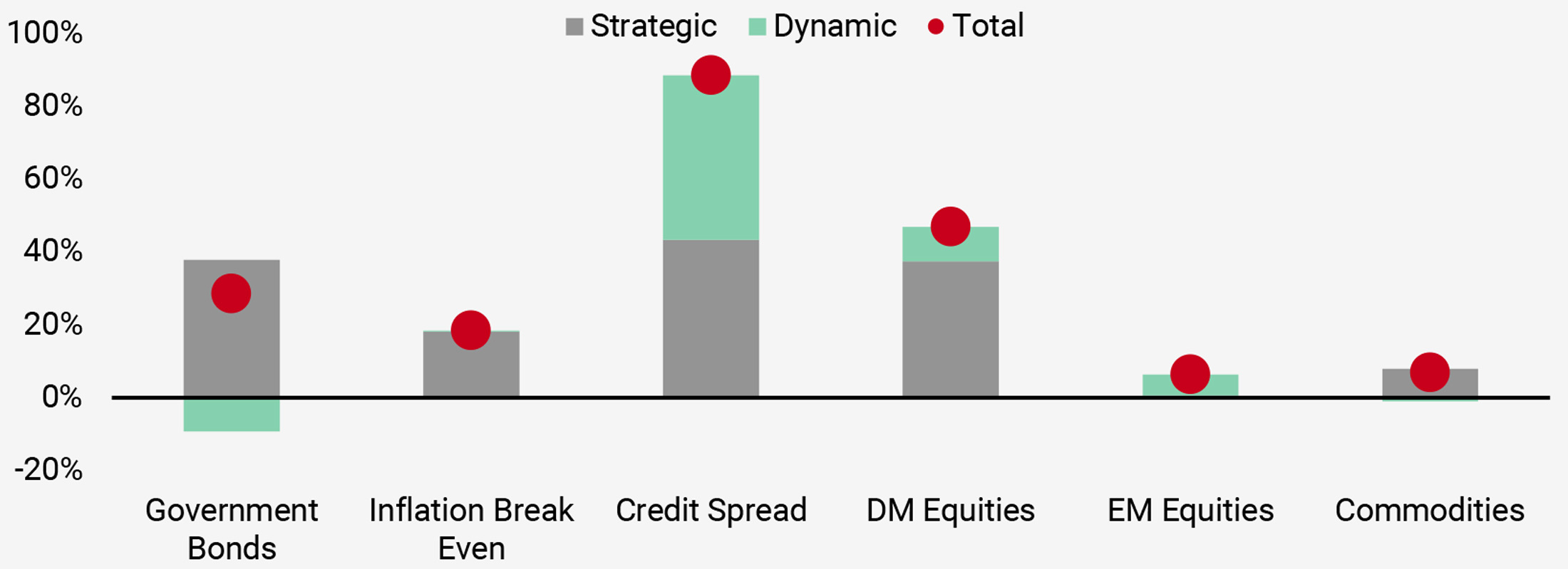
Figure 9b: A Fully Diversified Portfolio (capital allocation by risk premia)
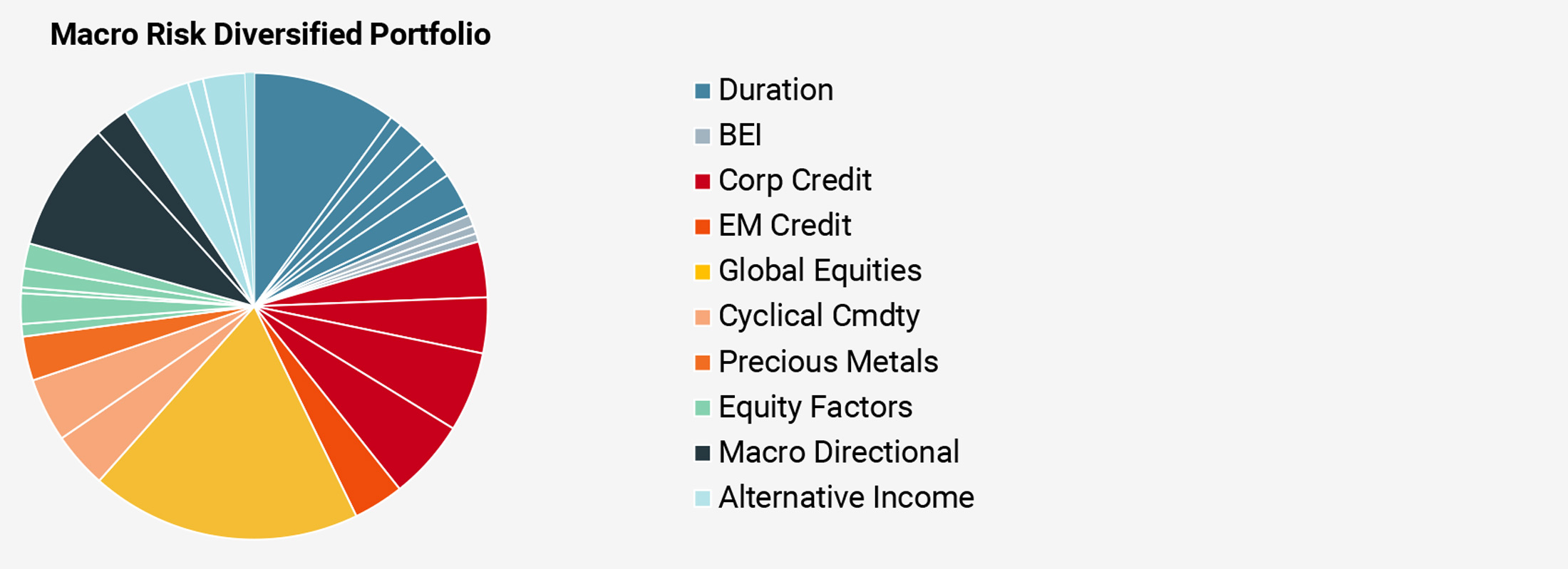
Against this backdrop, our main investment themes for 2020 are as follows:
- Although the global economy has been slowing for 15 months, we do not believe a recession is on the cards.
- With inflation nowhere to be found, we expect central banks to remain dovish, offering continued support to financial markets.
- While the outlook for growth-oriented assets remains positive, valuations are one area of concern.
- Within our multi asset portfolios, our preference is for equities and credit, but with greater discrimination than in the past.
We continue to believe that our macro risk-based strategy with its two core pillars – enhanced diversification and dynamic risk management – is well equipped to deliver positive and stable returns in the coming years.
Important Information
Past performance is no guide to the future, the value of investments, and the income from them change frequently, may fall as well as rise, there is no guarantee that your initial investment will be returned. This document has been prepared for your information only and must not be distributed, published, reproduced or disclosed by recipients to any other person. It is neither directed to, nor intended for distribution or use by, any person or entity who is a citizen or resident of, or domiciled or located in, any locality, state, country or jurisdiction where such distribution, publication, availability or use would be contrary to law or regulation. This is a promotional statement of our investment philosophy and services only in relation to the subject matter of this presentation. It constitutes neither investment advice nor recommendation. This document represents no offer, solicitation or suggestion of suitability to subscribe in the investment vehicles to which it refers. Any such offer to sell or solicitation of an offer to purchase shall be made only by formal offering documents, which include, among others, a confidential offering memorandum, limited partnership agreement (if applicable), investment management agreement (if applicable), operating agreement (if applicable), and related subscription documents (if applicable). Please contact your professional adviser/consultant before making an investment decision.
Where possible we aim to disclose the material risks pertinent to this document, and as such these should be noted on the individual document pages. The views expressed in this document do not purport to be a complete description of the securities, markets and developments referred to in it. Reference to specific securities should not be considered a recommendation to buy or sell. Investors shall conduct their own analysis of the risks (including any legal, regulatory, tax or other consequences) associated with an investment and should seek independent professional advice. Some of the investment strategies described or alluded to herein may be construed as high risk and not readily realisable investments, which may experience substantial and sudden losses including total loss of investment. These are not suitable for all types of investors.
To the extent that this report contains statements about the future, such statements are forward-looking and subject to a number of risks and uncertainties, including, but not limited to, the impact of competitive products, market acceptance risks and other risks. Actual results could differ materially from those in the forward-looking statements. As such, forward looking statements should not be relied upon for future returns. Targeted returns reflect subjective determinations by Unigestion based on a variety of factors, including, among others, internal modeling, investment strategy, prior performance of similar products (if any), volatility measures, risk tolerance and market conditions. Targeted returns are not intended to be actual performance and should not be relied upon as an indication of actual or future performance.
Data and graphical information herein are for information only and may have been derived from third party sources. Unigestion takes reasonable steps to verify, but does not guarantee, the accuracy and completeness of this information. As a result, no representation or warranty, expressed or implied, is or will be made by Unigestion in this respect and no responsibility or liability is or will be accepted. All information provided here is subject to change without notice. It should only be considered current as of the date of publication without regard to the date on which you may access the information. Rates of exchange may cause the value of investments to go up or down. An investment with Unigestion, like all investments, contains risks, including total loss for the investor.
Unigestion (UK) Ltd. is authorised and regulated by the UK Financial Conduct Authority (FCA) and is registered with the Securities and Exchange Commission (SEC). Unigestion Asset Management (France) S.A. is authorised and regulated by the French “Autorité des Marchés Financiers” (AMF). Unigestion Asset Management (Canada) Inc., with offices in Toronto and Montreal, is registered as a portfolio manager and/or exempt market dealer in nine provinces across Canada and also as an investment fund manager in Ontario and Quebec. Its principal regulator is the Ontario Securities Commission. Unigestion Asia Pte Limited is authorised and regulated by the Monetary Authority of Singapore. Unigestion Asset Management (Copenhagen) is co-regulated by the “Autorité des Marchés Financiers” (AMF) and the “Danish Financial Supervisory Authority” (DFSA). Unigestion Asset Management (Düsseldorf) SA is co-regulated by the “Autorité des Marchés Financiers” (AMF) and the “Bundesanstalt für Finanzdienstleistungsaufsicht” (BAFIN). Unigestion SA has an international advisor exemption in Quebec, Saskatchewan and Ontario. Unigestion SA is authorised and regulated by the Swiss Financial Market Supervisory Authority (FINMA). Unigestion SA’s assets are situated outside of Canada and, as such, there may be difficulty enforcing legal rights against Unigestion SA.
Unigestion SA is authorised and regulated by the Swiss Financial Market Supervisory Authority (FINMA). Unigestion (UK) Ltd. is authorised and regulated by the UK Financial Conduct Authority (FCA) and is registered with the Securities and Exchange Commission (SEC). Unigestion Asset Management (France) S.A. is authorised and regulated by the French “Autorité des Marchés Financiers” (AMF). Unigestion Asset Management (Canada) Inc., with offices in Toronto and Montreal, is registered as a portfolio manager and/or exempt market dealer in nine provinces across Canada and also as an investment fund manager in Ontario and Quebec. Its principal regulator is the Ontario Securities Commission. Unigestion Asia Pte Limited is authorised and regulated by the Monetary Authority of Singapore.
Uni-Global – Cross Asset Navigator is a compartment of the Luxembourg UniGlobal SICAV Part I, UCITS IV compliant. The compartment is currently authorised for distribution in Austria, Belgium, Denmark, Finland, France, Germany, Ireland, Italy, Luxembourg, Netherlands, Norway, Spain, UK, Sweden, Switzerland. In Italy, the compartment can be offered only to qualified investors within the meaning of art.100 D. Leg. 58/1998. The shares may not be offered or distributed in any country where such offer or distribution would be prohibited by law. All investors must obtain and carefully read the relevant prospectus which contains additional information needed to evaluate the potential investment and provides important disclosures regarding risks, fees and expenses. Unless otherwise stated performance is shown net of fees in USD and does not include the commission and fees charged at the time of subscribing for or redeeming shares.
No prospectus has been filed with a Canadian securities regulatory authority to qualify the distribution of units of this fund and no such authority has expressed an opinion about these securities. Accordingly, their units may not be offered or distributed in Canada except to permitted clients who benefit from an exemption from the requirement to deliver a prospectus under securities legislation and where such offer or distribution would be prohibited by law. All investors must obtain and carefully read the applicable offering memorandum which contains additional information needed to evaluate the potential investment and provides important disclosures regarding risks, fees and expenses.
